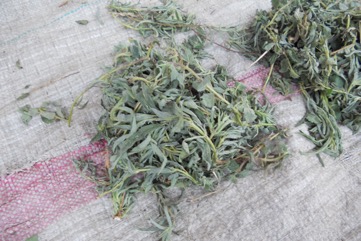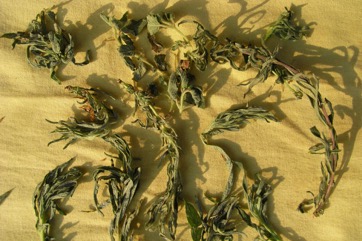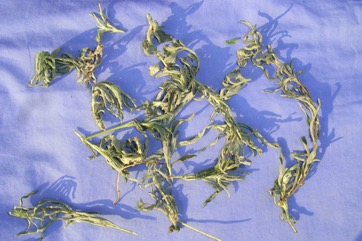False sesame

A tropical plant. It grows in the lowlands. It grows in tropical Africa. It grows on sandy soil. It suits wet areas. In Malawi it grows below 900 m altitude. In West Africa it grows in open savannah woodland.
Also known as:
Abadeib, Agbo, Alodi, Benona, Bulantam-o, Bulatam-o, Bungu, Chewe, Chinchesi, Chintengalalwa, Chinyololo, Chitelelu, Darraba t'al goz, Dowoungbaana, Ebolo, False benniseed, False sesame, Foyito, Gblogblo, Idjabo, Katate, Katate, Kpeewori, Lalo dane, Lalu-caminho, Lele, Ludvonca, Lunembwe, Maope, Mlenda mbata, Mulembwe utali, Mulyangumgu, N'zoti, Nkuyamani, Nor, Siwadompei, Tan-tan, Tchaba-laba, Thove, Tikpainn'tissedonte, Tiwadooti, Tobwe, Toubue, Xononm, Yodo, Yoroxlan, Zombwe
Synonyms
- Ceratotheca melanosperma Hochst. ex Bernh.
- Ceratotheca sesamoides Endl.
- Sesamum heudelotii Stapf
Edible Portion
- Leaves, Seeds, Seeds - oil, Pods, Vegetable
Where does False sesame grow?
Found in: Africa, Angola, Benin, Botswana, Burkina Faso, Cameroon, Central Africa, Central African Republic, CAR, Chad, Congo, Côte d'Ivoire, East Africa, Eswatini, Ethiopia, Gambia, Ghana, Guinea, Guinée, Guinea-Bissau, Ivory Coast, Kenya, Liberia, Malawi, Mali, Mauritania, Mozambique, Namibia, Niger, Nigeria, Senegal, Sierra Leone, South Africa, Southern Africa, Sudan, Swaziland, Tanzania, Togo, Uganda, West Africa, Zambia, Zimbabwe
Notes: Chemical composition (leaves and seeds): Protein (crude) = 8.5% (dry). Fat = 1.5% (dry). Fibre (crude) = 8,5% (dry). Ash (insoluble) = 20.2% (dry). Carbohydrate (soluble): Starch = 3.1% (dry). Sucrose = 3.5% (dry). D-glucose = 1.5% (dry). D-fructose = 0.1% (dry). Amino acids (g [16g N]-1): Aspartic acid = 17.2g. Threonine = 5.1g. Serine = 4.4g. Glutamic acid = 13.3g. Proline = 5.0g. Glycine = 5.7g. Alanine = 6.3g. Valine = 6.5g. Cysteine (performic acid oxidation) = 0.7g. Methionine (performic acid oxidation) = 1.9g. Isoleucine = 5.5g. Leucine = 9.4g. Tyrosine = 4.2g. Phenylalanine = 5.7g. Lysine = 5.2g. Histidine = 2.1g. Arginine = 6.1g. Minerals: Sulphur = 0.23% (dry). Potassium = 0.23% (dry). Magnesium = 0.48% (dry). Calcium = 1.48% (dry). Na = 0.02% (dry). Zinc = 36 mg/kg-1 (dry). Iron = 194 mg/kg-1 (dry). Manganese = 173 mg/kg-1 (dry). Copper = 15 mg/kg-1 (dry). Aluminium = 137 mg/kg-1 (dry).
Status: It is commonly and widely used in Malawi. It is highly palatable.
Growing False sesame
Cultivation: Plants are grown from seeds. Seeds are broadcast at the beginning of rains.
Edible Uses: The leaves are eaten as a vegetable. They are collected and wilted in the sun. They can be added to soups. Leaves can be preserved by drying. They are also dried in the sun and pounded with other vegetables and boiled as a thick paste. The seeds are eaten like sesame seeds. They are also put into soups. The seeds yield an edible oil.
Production: Leaves are collected during the rainy season. They are available at other times if there is sufficient soil moisture. They can be dried and stored.
Nutrition Info
per 100g edible portion| Edible Part | Energy (kcal) | Protein (g) | Iron (mg) | Vitamin A (ug) | Vitamin c (mg) | Zinc (mg) | % Water |
|---|---|---|---|---|---|---|---|
| Leaves | 54 | 4.2 | 3.2 | - | - | - | 81 |
| Pods | - | - | - | - | - | - | |
| Seeds dried | 550 | 14.2 | - | - | - | - | 7 |
False sesame Photos



References
Abbiw, D.K., 1990, Useful Plants of Ghana. West African uses of wild and cultivated plants. Intermediate Technology Publications and the Royal Botanic Gardens, Kew. p 41
ABDELMUTI,
Achigan-Dako, E, et al (Eds), 2009, Catalogue of Traditional Vegetables in Benin. International Foundation for Science.
Acipa, A. et al, 2013, Nutritional Profile of some Selected Food Plants of Otwal and Ngai Counties, Oyam District, Northern Uganda. African Journal or Food, Agriculture, Nutrition and Development. 13(2)
Ayantunde, A. A., et al, 2009, Uses of Local Plant Species by Agropastoralists in South-western Niger. Ethnobotany Research and Applications. Vol. 7: 53-66
Avouhou, H. T., et al, 2012, Ethnobotanical Factors Influencing the Use and Management of Wild Edible Plants in Agricultural Environments in Benin. Ethnobotany Research & Applications Vol 10:571-592
Batawila, K., et al, 2007, Diversite et gestion des legumes de cueillete au Togo. African Journal of Food, Agriculture, Nutrition and Development 7( 3& 4): 67
Belem, M., et al, 2017, Strategy of Conservation and Protection of Wild Edible Plants Diversity in Burkina Faso. ANADOLU 27 (2) 2017, 82- 90
Burkill, H. M., 1985, The useful plants of west tropical Africa, Vol. 1. Kew.
Busson, 1965,
Codjia, J. T. C., et al, 2003, Diversity and local valorisation of vegetal edible products in Benin. Cahiers Agricultures 12:1-12
CRÉAC'H,
Dalziel, J. M., 1937, The Useful plants of west tropical Africa. Crown Agents for the Colonies London.
Dansi, A., et al, 2008, Traditional leafy vegetables and their use in the Benin Republic. Genet Resour Crop Evol (2008) 55:1239–1256
Dansi, A., et al, 2012, Diversity of the Neglected and Underutilized Crop Species of Importance in Benin. The Scientific World Journal. Volume 2012, Article ID 932947, 19 pages
Diouf, M., et al, Leafy Vegetables in Senegal. Bioversity webite
Facciola, S., 1998, Cornucopia 2: a Source Book of Edible Plants. Kampong Publications, p 168
Fowler, D. G., 2007, Zambian Plants: Their Vernacular Names and Uses. Kew. p 52
Gallagher, D. E., 2010, Farming beyond the escarpment: Society, Environment, and Mobility in Precolonial Southeastern Burkina Faso. PhD University of Michigan.
Grivetti, L. E., 1980, Agricultural development: present and potential role of edible wild plants. Part 2: Sub-Saharan Africa, Report to the Department of State Agency for International Development. p 29, 49
Grubben, G. J. H. and Denton, O. A. (eds), 2004, Plant Resources of Tropical Africa 2. Vegetables. PROTA, Wageningen, Netherlands. p 175
Harris, F. M. A. and Salisu Mohammed, 2003, Relying on nature: Wild Foods in Northern Nigeria. AMBIO Vol. 32 No. 1, p 27
http://www.fao.org/forestry/25323-096344a3de335832e8f363c3ac5184a66.pdf
Jardin, C., 1970, List of Foods Used In Africa, FAO Nutrition Information Document Series No 2.p 40, 65
Long, C., 2005, Swaziland's Flora - siSwati names and Uses http://www.sntc.org.sz/flora/
Lyimo, M., et al, 2003, Identification and nutrient composition of indigenous vegetables of Tanzania. Plant Foods for Human Nutrition. 58: 85-92
Lykke, A. M., Mertz, O, and Ganaba, S., 2002, Food Consumption in Rural Burkina Faso, Ecology of Food and Nutrition, 41:119-152
Malaisse, F., 1997, Se nourrir en floret claire africaine. Approche ecologique et nutritionnelle. CTA., p 91.
Martin, F.W. & Ruberte, R.M., 1979, Edible Leaves of the Tropics. Antillian College Press, Mayaguez, Puerto Rico. p 211
Masters, T., 2021, Traditional food plants of the upper Aswa River catchment of northern Uganda—a cultural crossroads. Journal of Ethnobiology and Ethnomedicine (2021) 17:24
Mertz, O., Lykke, A. M., and Reenberg, A., 2001, Importance and Seasonality of Vegetable Consumption and Marketing in Burkina Faso. Economic Botany, 55(2):276-289
Mpasiwakomu, R. A., 2017, The Diversity and Utilization of Wild Edible and Medicinal Plant Species found in Uvinza Miombo Woodlands, Tanzania. M. Sc. thesis University of Tanzania.
Nayar, N.M., 1979, Sesame, in Simmonds, N.W., (ed), Crop Plant Evolution. Longmans. London. p 231
N'Danikou, S. et al, 2010, Eliciting Local Values of Wild Edible Plants in Southern Bénin to Identify Priority Species for Conservation. Economic Botany, 20(10), 2011, pp. 1–15.
Newman, 1970,
Okigbo, B.N., Vegetables in Tropical Africa, in Opena, R.T. & Kyomo, M.L., 1990, Vegetable Research and development in SADCC countries. Asian Vegetable Research and development Centre. Taiwan. p 44
Peters, C. R., O'Brien, E. M., and Drummond, R.B., 1992, Edible Wild plants of Sub-saharan Africa. Kew. p 159
Pickering, H., & Roe, E., 2009, Wild Flowers of the Victoria Falls Area. Helen Pickering, London. p 91
Ruffo, C. K., Birnie, A. & Tengnas, B., 2002, Edible Wild Plants of Tanzania. RELMA p 196
Ruiters-Welcome, A. K., 2019, Food plants of southern Africa. Ph.D. thesis. Univ. of Johannesburg p 85
Salvi, J. et al, 2016, A review: Underutilized wild edible plants as a potential source of alternative nutrition. International Journal of Botany Studies. Volume 1; Issue 4; May 2016; Page No. 32-36
Scudder, 1962, 1971,
Segnon, A. C. & Achigan-Dako, E. G., 2014, Comparative analysis of diversity and utilization of edible plants in arid and semi-arid areas in Benin. Journal of Ethnobiology and Ethnomedicine 2014, 10:80
Sena, L. P., et al, 1998, Analysis of nutritional components of eight famine foods of the Republic of Niger. Plant Foods for Human Nutrition 52: 17–30
Swaziland's Flora Database http://www.sntc.org.sz/flora
Tanaka,
Uphof,
USDA, ARS, National Genetic Resources Program. Germplasm Resources Information Network - (GRIN). [Online Database] National Germplasm Resources Laboratory, Beltsville, Maryland. Available: www.ars-grin.gov/cgi-bin/npgs/html/econ.pl (10 April 2000)
Vanderjagt, F. J., et al, 2000, The trypsin inhibitor content of 61 wild edible plant foods of Niger. Plant Foods for Human Nutrition 55: 335–346, 2000.
Vernon, R., 1983, Field Guide to Important Arable Weeds of Zambia. Dept of Agriculture, Chilanga, Zambia. p 70
West African Food Composition Tables. 2012. FAO
Williamson, J., 2005, Useful Plants of Malawi. 3rd. Edition. Mdadzi Book Trust. p 61